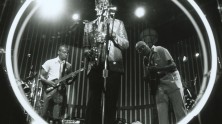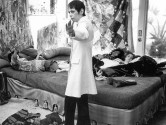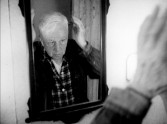





To the Beat of Shirley Clarke
Born into both privilege and neglect in New York City, Shirley Brimberg Clarke (1919 – 1997) never seemed comfortable with society’s expectations and attempted to break free from convention at an early age. Ambitious and intelligent, yet unable to conform to standard education, she initially found her voice through dance. Studying under Martha Graham, Hanya Holm, Doris Humphrey and Anna Sokolow, Clarke would take all of the dance classes a college had to offer and then move on. At the end of her options, she finally escaped from the burdensome demands of her parents by marrying supportive friend and lithographer/publisher Bert Clarke. The marriage provided Clarke with the independence and freedom to do what she wanted and eventually decided her fate; she received a 16mm Bolex camera as a wedding present.
Responding to the choreography, movement and rhythm inherent in the medium, Clarke’s relationship to film began as an extension of her dance. Making her first film, A Dance in the Sun, unaware of Maya Deren’s film work with dance and spatio-temporal cutting, she transported a dancer on stage back and forth through time and space, landing him back to unceremonious reality as the credits roll. The essential elements of this first effort would reverberate throughout her work and approach to life. As she reflected in a later interview, “Everything I’ve done is based on the duality of fantasy and reality.” Taken in by the expressive beauty of motion and the transcendent powers of art, she also accepted and investigated film’s manipulative and exploitive aspects. Clarke harnessed the power of cinema to create a parallel dimension, while grounding the journey by hiding her cinematic tactics in plain sight.
Clarke also positioned herself as a formative organizing force in the fertile, intimate, interdisciplinary revolution that was the New American Cinema scene in Fifties and Sixties New York. She studied film at City College of New York programs helmed by Hans Richter, joined the Independent Filmmakers Association, attended Cinema 16 screenings and eventually founded the New American Cinema Group with fellow enthusiastic film zealot Jonas Mekas—eventually playing a vital role in setting up Film-Makers Coop with Mekas.
Meanwhile, her initial dance films led to a series of kinetic, poetic loops for the 1958 Brussels World’s Fair. Using a visual sort of jazz as her structure, she weaves a mix of dazzling optical effects with clever contextualizing—never merely presenting her subject, but interjecting a point of view and complicating a straight-forward reading. Her inventive excursions would continue in longer, commissioned works like the sweet and haunted UNICEF promotional A Scary Time and the “musical comedy” Skyscraper with Willard Van Dyke.
Screening and lecturing regularly, Clarke also co-founded the production and distribution collective Filmmakers Inc. with many of her fellow World’s Fair documentarians and their colleagues—Van Dyke, Richard Leacock, Albert Maysles and D.A. Pennebaker—who were all interested in the socially relevant aspect of new cinema. Filmmakers Inc. became a hub that drew like-minded pioneers like John Cassavetes who borrowed Clarke’s equipment to make his groundbreaking first film Shadows (1958).
As was her inclination, Clarke confronted the problematics of the very cinema verité ethos she embraced. In her first feature-length film The Connection she challenged the objectivity and authority of the—usually male—director’s gaze and the concealed construction of a narrative—patriarchal elements which remained even within the more spontaneous, naturalistic documentary approach. The Connection’s underground characters voice the unspoken concerns of those at the end of the documentarian’s gaze—humiliation, judgment, exploitation—while the director stands in for all pretentious filmmakers as well as partly for Clarke who was continually questioning her role in the larger production of life which spilled beyond the cinema.
Clarke’s marginalized position as a female filmmaker afforded her an authentic, deeply felt outsider/insider view; thus, her subject matter of her films also spotlit the alienated, the oppressed, the othered. Unable to even conform to a “standard” format, Clarke instead inhabited the spaces in between art forms, in between dance and film, documentary and fiction, performance and experience.and later film and video. Complicating with multiple perspectives, rather than a unified voice, Clarke made visible and then attempted to dissolve the complex of barriers in art and society, most acutely in The Cool World and Portrait of Jason.
Clarke and Mekas also created the New York’s Film-Makers Distribution Center together with Louis Brigante, similar to Film-Makers’ Coop, yet focused on bringing the avant garde to commercial theaters. As with her films, it was as if Clarke wanted to directly challenge “square” Hollywood with its orphaned, marginalized child, rather than quietly send it away to the cloistered halls of the art house and academia. Their effort was relatively short-lived, yet set the stage for independent distribution which would eventually emerge as a formidable force within Hollywood’s studio monopoly.
While teaching and experimenting with the emerging video technologies of the Seventies, Clarke’s energy and innovation carried on. Forming a community of artists, the Tee Pee Videospace troupe, from her bustling Chelsea Hotel penthouse, she organized open-ended games with cameras and monitors, and on tour created interactive antics like the Video Ferris Wheel and the fortune-telling VID-E-ORACL. After these radically playful, evanescent collaborations, she made a series of single-channel video pieces and released her cosmic tribute to Ornette Coleman.
Not without many followers and accolades during her lifetime—including the Critics Award at Cannes for The Connection and an Oscar for her Robert Frost documentary—Clarke still had to fight the discrimination she experienced as a female filmmaker; likewise, she has been noticeably neglected from underground cinematic history.
The Harvard Film Archive will present the wild and wonderful world of Shirley Clarke via a retrospective of all of her features in addition to a selection of shorts, interviews and home movies. Milestone Films’ Dennis Doros—who has overseen the restoration of many of her films—will be in attendance to present the short film program. – Brittany Gravely
Visit Milestone Films' Project Shirley website for more information on Shirley Clarke and the restoration of her films.









